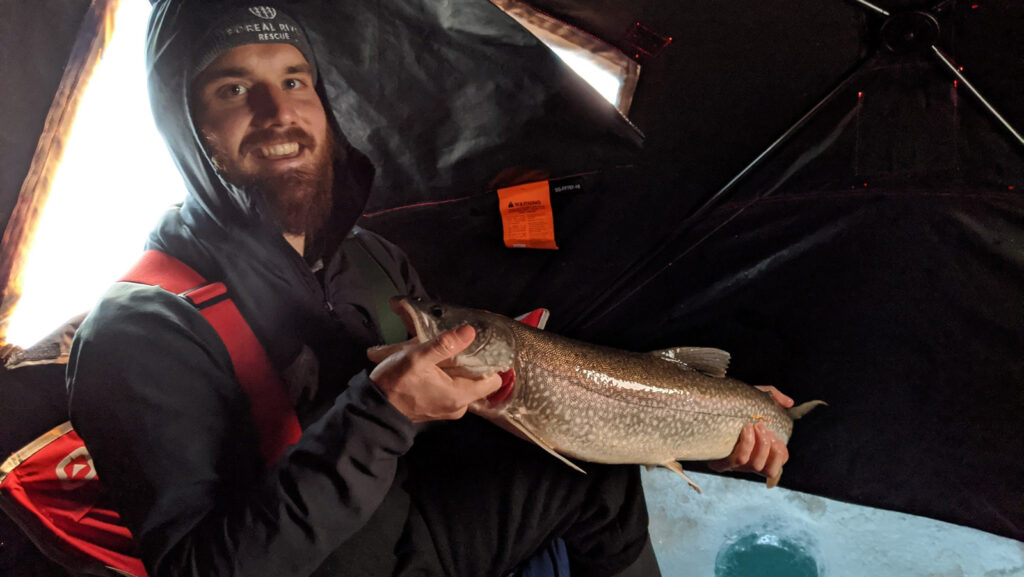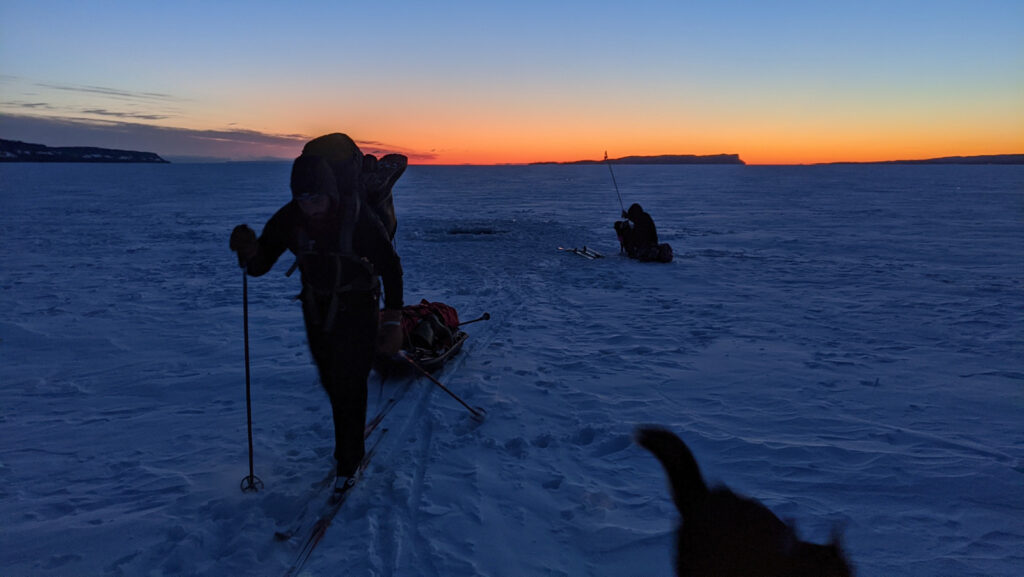Fundamentals of Ice Fishing Safety
By Willa Mason, Boreal River
Ice is dynamic. Your safety approach should be too.
Wind, weather, and currents cause ice conditions to change in a matter of hours. This is why it’s essential to assess (and constantly reassess) ice for yourself.
Taking someone else’s word on ice conditions might lead you onto unsafe ice, especially if they arrive there the next day, after the ice has been affected by the environmental factors, and are unable to recognize the warning signs that the ice is now unstable.
Your approach should be adapted based on the time of year, the size of your group, your activity, and the ice thickness.

Photo: Joey Miller
Ice Fishing Equipment
Adapt to the time of year
Early on in winter, ice is generally new and very thin. It’s important to prepare as if you are going to fall in. Bring your self-rescue equipment with you, but leave your fishing equipment on safe ice or solid ground. Once you have ventured onto the ice and confirmed its quality, you can go back to retrieve your fishing gear. This is sure to be easier than retrieving your gear out of the water if the ice turns out to be unsafe!
Adapt to the size of your group
Naturally, the weight of multiple humans is much greater than that of a single human. Particularly on a cold day, those people will want to huddle closer together, or gather inside of a shack. This means the weight is distributed over a smaller surface area, and the ice needs to be assessed accordingly.
Also read: 6 Fundamentals of Ice Assessment
If you’ll be sitting in one place, near your ice hole, for an extended period of time, it’s a good idea to bring something to help distribute your weight, such as a large piece of plywood.
Adapt to your mode of travel
It’s important to adapt your ice safety assessment and preparedness to match your mode of travel.
An ice fisher reaching their destination by skiing will have their weight distributed across a larger surface area, thanks to their skis. They’re also more likely to be dressed in layers, which can be warmer when wet than a big cotton sweater. Ski poles can also act as makeshift ice picks to help with self-rescue.
Ice fishers travelling by snowmobile should bring the rescue equipment needed to pull it out of the water, should it fall through. They should also pack for the eventuality of getting stuck in slush, including the possibility of having to spend the night outside, should the snowmobile leave them stranded far from help.
In some cases, a simple ice climbing screw and a throw bag may be the minimalist rescue kit needed to save a life. Lightweight and versatile, these pieces of gear are great staples for anyone travelling by ice. Mechanical advantage systems, carabiners, webbing, and a lifejacket may be essential pieces of an ice fishing kit when travelling by snowmobile or when adventuring on precarious ice. A seasoned expert may carry all of those items when fishing on 3” of ice, but carry nothing when fishing on ice that is 3ft thick. While many people carry a spud to check the ice thickness, it won’t save you from frigid waters, but could prevent you from going in, if you adjust your plan based on your findings.

Photo: Joey Miller
Ice Fishing Safety
Ice assessment
The more you assess ice, the more you will recognize patterns. For people just learning to ice fish, it can be hard to compensate for that experience. That’s why it’s important to go with people who know or to take a course.
Adaptable Plan
Ice that is 18’’ thick might make it a great day to introduce your friend to ice fishing. On ice that is 2’’ thick, it may not be safe to stand close to your friend. Venturing onto thin ice can be thrilling and rewarding, but it requires each person to be comfortable and self-sufficient with every possible situation, from reeling in their huge catch to pulling themselves out of the water.
A sight hole, which consists of removing a large block of ice through which you can watch fish nibble at your line, is a fascinating way to get a glimpse of the underwater world. However, there are right and wrong conditions for this. Surrounding ice will gradually bend towards the opening, creating a dangerous slope leading to open water. A couple additional inches is required on top of a regular acceptable thickness.
Ice is dynamic, and your plan should be to. It may be heartbreaking to drive three hours to a pristine ice fishing spot, only to see that the ice is too thin. Remember that you can, and sometimes should, turn around. Keep getting out there, testing the ice, and overtime you’ll be rewarded with dreamy and fulfilling ice fishing days.
This article is intended to explain some of the factors involved in safe ice fishing, and is not a substitute for proper ice safety education and training.
Special thanks to Joey Miller for weighing in on this topic. Joey is an avid ice fisher and Boreal River Rescue ice rescue instructor based out of Thunder Bay, Ontario.
Links
Read: 6 Fundamentals of Ice Assessment
Read: How to self-rescue if you fall through ice
Training: Ice Rescue & Safety Training

